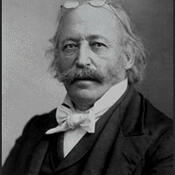 After the Civil War, many German-born rabbis immigrated to the United States, where they helped to organize and solidify the Jewish Reform movement. They sought to align the Jewish and the American experience and to loosen many traditional rules and requirements of Jewish prayer and practice.
After the Civil War, many German-born rabbis immigrated to the United States, where they helped to organize and solidify the Jewish Reform movement. They sought to align the Jewish and the American experience and to loosen many traditional rules and requirements of Jewish prayer and practice.
American Judaism began moving toward reform around the time of the Civil War. The second generation of German Jews was just coming of age and their ongoing acculturation into America was accompanied by religious modification, each process supporting the other. By the mid-19th century, an institutionalized movement of Reform Judaism was well established. During the same period, however, more traditionalist Jews initiated a number of countermeasures which ultimately gave rise to the denominational movements of Orthodox and Conservative Judaism. But the trend toward modernization was strong, and no form of Judaism survived this period of American experience unchanged.
The first site in the process of reform was the Americanization of the synagogue. During the 1860s and 70s, congregations around the country began to introduce mixed seating and family pews, replacing the custom of separate seating for men and women. According to Jonathan Sarna, author of The Debate over Mixed Seating in the American Synagogue, this trend first began by mistake when Rabbi Isaac Meyer Wise moved his new congregation into a building that used to be a church. For financial reasons, the decision was made to keep the existing family pews instead of retrofitting the building with exclusively separate seating. Gradually, choirs, organ music, English-language sermons, and prayers were introduced into the service. These changes stood in direct opposition to the norms of the traditional synagogue service. While some communities reformed with the support of their progressive rabbis, others instituted changes against their rabbi’s wishes. Never intending to change the essentials of Jewish law, American Jews nevertheless felt free to adjust historic Jewish customs in order to attune the externals of Jewish practice to their new environment. As with many immigrants, their motives were to reduce the dissonance between Jewish and American ways of life so that they and their children might better be able to identify with Judaism and America at once.
During this period, a steady flow of modern German-born, university-trained rabbis began to arrive in the United States. They brought with them an ideology of religious reform that struck at the heart of traditional Judaism. In essence, the European Reform movement retained the ethical monotheism of prophetic Judaism while rejecting the ritual laws and cultural particularism of biblical and rabbinic Judaism. At first, these rabbis’ progressive messages were met with little appreciation from more traditional American congregants. But as the rabbis learned to convey their ideals in more familiar American terms, the platform of Reform Judaism became more widely accepted.
The major proponents of the new orthopraxy were rabbis Isaac Meyer Wise, David Einhorn, Kaufmann Kohler, and Emil G. Hirsch. In 1873, Wise created the Union of American Hebrew Congregations, the first congregational union in American Judaism and the founding institution of the Reform movement. Two years later he founded and assumed leadership of Hebrew Union College in Cincinnati, Ohio, which became the intellectual heart of the new Reform Judaism and the first permanent institution to begin training American rabbis.
The high water mark of classical Reform Judaism came in 1885 when, under the influence of Rabbi David Einhorn, a group of Reform rabbis met in Pittsburgh to clarify their position. The resulting document, known as the Pittsburgh Platform, contained the guiding principles of the American Reform movement. These included provisions which abrogated most of traditional, European “Mosaic legislation” as well as many national aspects of Judaism. Since 1885, Reform Judaism has undergone much evolution, with leadership continuing to meet in Columbus in 1937 and in San Francisco in 1976 to amend the original platform. In both cases the movement responded to changes that were already taking shape, finding the rationale to reintroduce more traditional practices and greater ethnic/national identification into Reform Jewish life. The history of Reform Judaism thus reveals a central theme in American religion: the response of religious leaders to the urgings of the people. Just as the Pittsburgh Platform was preceded by the self-reformation of the American synagogue, American Judaism tends on the whole to be the product of the people rather than the elite.